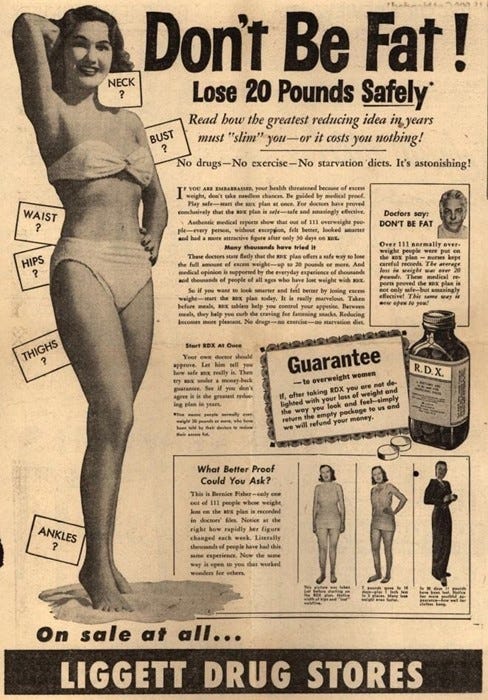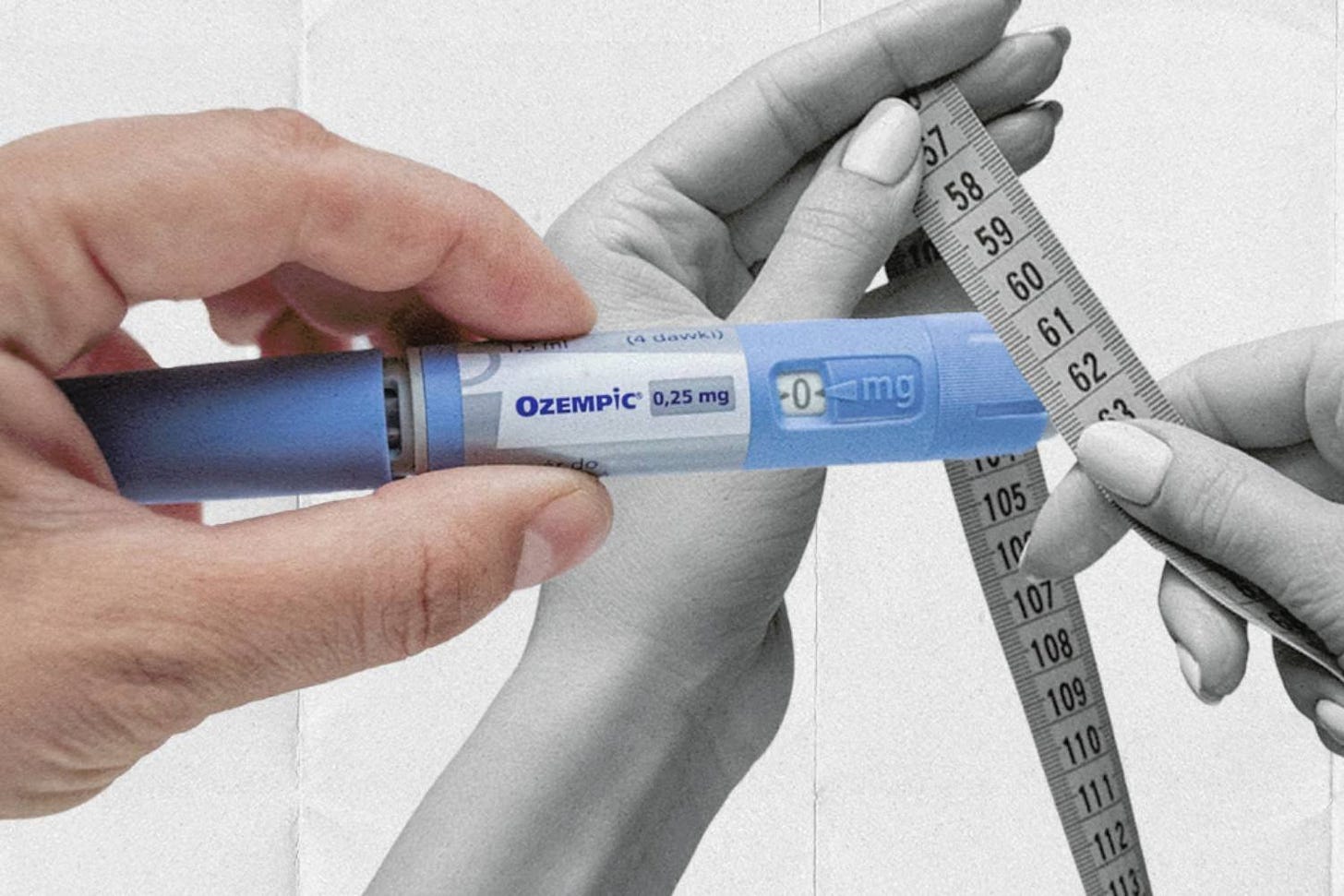Warning: Don't be fat!
Ozempic's celebrity status and secret side effects • Plus: The only lipgloss you need (again) now
BeWell | The Midst beauty, style & wellness newsletter
Exclusive for subscribers to The Midst Substack
Let me start by saying, no shade to anyone who wants to inject drugs like Ozempic for weight loss. In theory, I’d love to try it. But needles? Semaglutide? That’s all way too scary to me. To be honest, I promised myself I wouldn’t “go hard” on weight loss after I recovered from all of my eating disorders. Plus, it’s not the what (the drug) that concerns me — it’s the why.
Women’s bodies and appearances are hot commodities. Always have been. Even 100 years ago in the 1920s, we GALs smoked cigs, took laxatives, and smooshed into girdles to fit into prescribed beauty standards. We downed amphetamines (speed) in the ‘50s and ‘60s, took fenfluramine (seizure meds) and dexfenfluramine (appetite suppressants) in the ‘70s and ‘80s, then added phentermine to fenfluramine (“phen-fen” as we called it) in the ‘90s — all prescribed meds with cardiovascular risk, sometimes causing death. Meridia and Reductil soon followed for “metabolic syndrome” … and today’s drug of choice, Ozempic, needs no introduction.
In many aspects, Ozempic and other appetite-suppressing drugs have been effective, and even crucial, for those who need them for health conditions like diabetes, obesity, and weight-related health concerns. But, to no surprise, celebrities and “thinfluencers” have been getting their hands on the drug for off-label use — Ozempic is currently only recommended for those with type 2 diabetes. The spurring trend of finding a way to get a prescription by any means necessary has trickled down to us non-celebs, creating an impressive demand — and a frightening supply shortage for folks who need them to survive.
(Read pharmaceutical writer Emily Ornberg’s research on the drug below.)
Will we ever be free?
I’m (obviously) victim to the swirl — I think we all are. The Women’s Body Commodity runs the spectrum of health and creativity to, dare I say it, oppression. The key here is information, and with everything available at our fingertips, no one should have trouble researching her drug of choice, with us writers at The Midst here to help. (Botulinum toxin? Bring it!) As long as you know what you’re getting into and why, it’s your body to do what you damn well please. In the meantime, yours truly will be tracking what she eats on Noom, ordering more Spanx, and wondering how today’s diet drug ads will read long after our bodies expire.
Blow ‘em a “Black Honey” smooch
How did I forget about this gem of a beauty product?
Clinique launched “Black Honey” in a little pot, hence the name, back in 1971. This sheer, gorgeous lipgloss had a glow-up in the ‘80s when it transitioned to a stick form, and by the ‘90s, girls all over campus were wearing this hue like a uniform — myself included.
What makes this lip a winner for every GAL?
While the color in the tube looks dark, almost black, the sheer formula wears like a tint and compliments every skin tone. According to Clinique, “The secret is its perfect blend of blue, red, and yellow pigments in a creamy, sheer base that melts into lips, playing up their natural color.”
“Black Honey” can be applied like lip balm — so no need for liner or even a mirror, for that matter! You can wear it alone or over another hue for a boost of shine. Plus, it’s comprised of “95% conditioning ingredients” and is free of fragrance, parabens, and phthalates. Its hydration is ideal for GALs our age, and the hue is classic — never out of style, and perfect for both day and night.
Thankfully, my sneaky Amazon algorithm reminded me to add this cult-favorite to my makeup kit once again. If you’re up for a smooch revival, get yours, too!
Ozempic: Weighing the pros and (often hidden) cons
“Nothing tastes as good as skinny feels.”
That refrain has been repeated since Kate Moss popularized it in the 2000s. And if you are like me, the 1 in 3 adults in the US who are overweight, it reminds you of the stigma that is often tied to fatness: you’d rather indulge yourself with food than opt for the skinny life, a life you may never get a taste of. As though body size is solely a reflection of discipline, and not a result of a demanding, sedentary, junk-food-filled society.
Yes, obesity is a health crisis. But our nation’s weight issue is not only a medical concern, but a cultural one, too. Study after study validates that overweight people, especially women, face stigma and discrimination that result in favoring the fit. That’s been socially acceptable for decades.
But this anti-obesity boom is only just beginning. As worldwide obesity rates continue to rise, drugs like Ozempic and Wegovy (powered by a molecule called semaglutide) and Mounjaro (which uses tirzepatide) became the first pharmaceutical brands to reach celebrity status across social media. While Ozempic is currently prescribed for those who have type 2 diabetes, each of these appetite-suppressing drugs have proven to be effective in promoting weight loss, including menopausal weight gain. And future versions of these glucagon-like peptide-1 (GLP-1) medicines could be game-changers: In clinical trials, they’re showing to not only stave hunger, but improve the way your body breaks down sugar to boot.
From possible side effects like “Ozempic personality” to potentially curing addictions, here’s the skinny on the lesser known side effects of weight loss drugs (before you start to feel seduced by these injectable hormones).
Keep reading with a 7-day free trial
Subscribe to The Midst to keep reading this post and get 7 days of free access to the full post archives.










